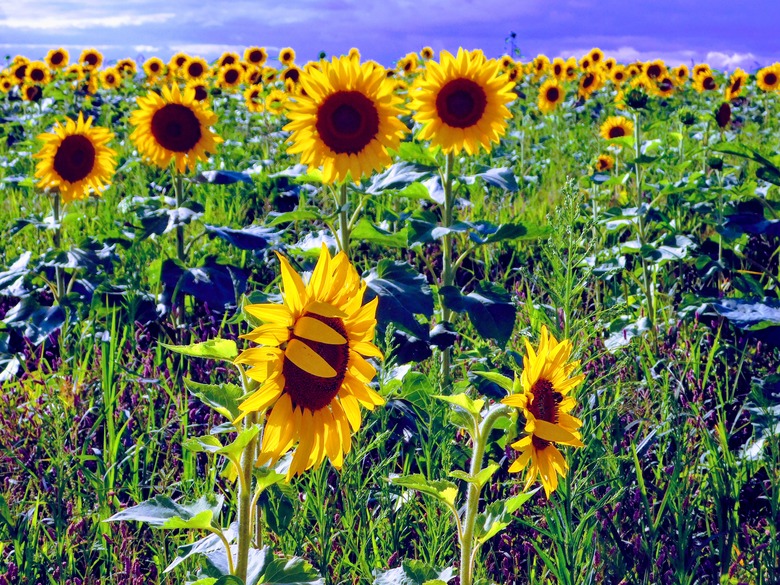How To Treat Sunflower Pests
We may receive a commission on purchases made from links.
Sunflowers (Helianthus spp.) are so-named because their yellow ray flowers emanating from the oversized seed heads look strikingly similar to artistic depictions of the sun that you may have seen in medieval literature. The seeds are delicious and nutritious and are an important reason sunflowers are cultivated, but it isn't just people who like them. In fact, the list of sunflower pests is quite long, and if you're wondering how to treat sunflower pests, the answer is to treat them decisively if you want to save any seeds for yourself.
Sunflowers aren't as attractive to thrips, spider mites and other microscopic crawlies as other plants, probably because they grow so tall (6 feet or more) and so quickly, which means that the insects damaging your plants are usually big enough to spot, making management easier. Not all insects you find on sunflowers are harmful, and some, like ladybugs, are beneficial, so you don't need to freak out every time you see a bug. However, stunted growth, decimated foliage and wilting coupled with insect sightings should call you to action.
Below- and Above-Ground Insects
Below- and Above-Ground Insects
Some insect pests live in the soil and do their damage to the roots or to the young annual plant as it's emerging. The damage they do can stunt the plant growth or kill the plant outright. These subterranean pests include:
- Cutworms
- Wireworms
- Sunflower root weevil larvae
Other insect pests prefer to feed on the stalks. They can gird the stalk, causing breakage, or create wounds that get infected by fungal pathogens. They include:
- Dectes stem borers
- Sunflower stem weevils and black sunflower stem weevils
- Sunflower maggots
Still other insects feed on the leaves and can completely defoliate a plant and kill it. Foliar feeders include:
- Palestriped flea beetles
- Sunflower beetles
- Thistle caterpillars
A large group of insect scavengers ignore the rest of the plant and go straight for the head, where the best meal is to be had. The insects in this group include:
- Lygus bugs
- Sunflower headclipping weevils
- Red and gray sunflower seed weevils
- Sunflower moths, sunflower bud moths and banded sunflower moths
- Sunflower midges
- Sunflower receptacle maggots
- Sunflower seed maggots
Managing So Many Pests
Managing So Many Pests
Some insect pests can decimate a crop and inflict serious economic harm, so if you're growing sunflowers as a crop, you'll want to identify the insects you see and treat them with the appropriate insecticide. If you're just growing a few sunflowers in the backyard garden, though, you don't have to be so thorough. If you spot insects, you can often pick them off, or when that isn't practical, you can spray them with a garden-friendly insecticidal soap.
It's more difficult to treat subterranean pests, like cutworms and wireworms, because by the time the damage they inflict becomes noticeable, it's often too late. Avoid these pests by turning the soil well to disrupt their habitat before you plant the sunflowers.
What About Four-Legged Pests?
What About Four-Legged Pests?
It isn't just insects who are attracted to sunflowers but virtually every animal that roams the forest or burrows underground. Of these, deer and rabbits are the most likely to eat your growing plants, and you can often deter deer by planting shrubs and trees they avoid, such as holly, bottlebrush, juniper and rhododendron. When it comes to rabbits, the best exclusion strategy is usually a knee-high fence around the garden area or to use a commercial repellent.
